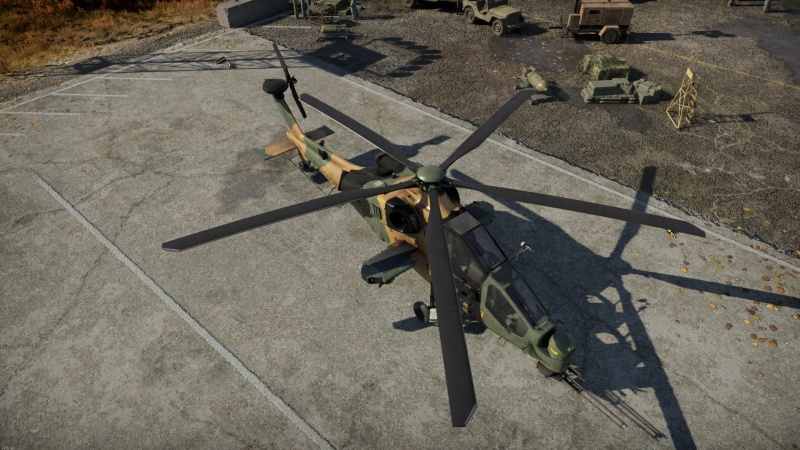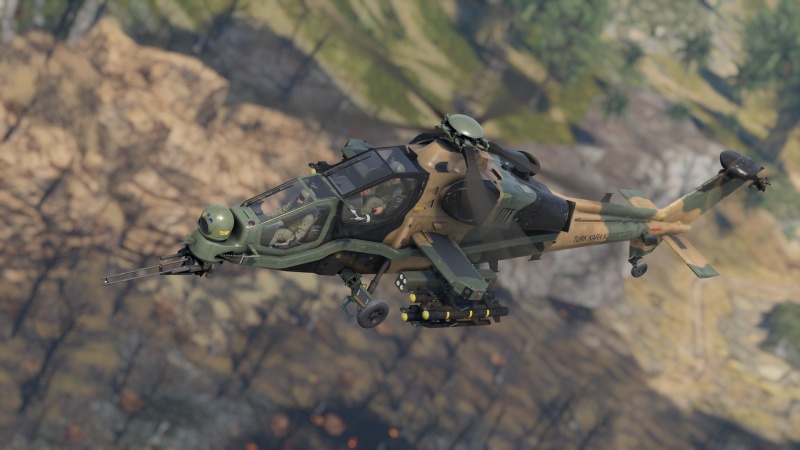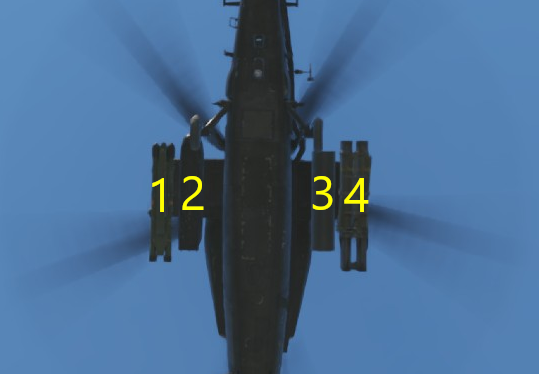T129
| This page is about the gift Italian attack helicopter T129. For other versions, see AW129 (Family). |
Contents
Description
The T-129 ATAK was a modified version of the A129 Mangusta made by Italy for the Turkish Air Force's ATAK programme. In March 2007, the Turkish government began negotiations with Agusta-Westland to jointly develop a new variant of the A129 Mangusta. The changes included stronger engines in the form of the CTS 800 and different avionics and optics compatible with Turkish weapons. The first serial T129 was delivered to the Turkish army in 2014. By 2024, Turkey had over 50 T129s of various modifications in service, and a number were also supplied to the Philippines and Nigeria.
Introduced in Update "Drone Age", the T129 differs from the Italian A129CBT particularly in its armaments: instead of Hellfires, the T-129 is equipped with Turkish-made L-UMTAS and CIRIT missiles. The L-UMTAS have a very long travel time, which lowers the efficiency of the helicopter and allows them to be easily evaded. The CIRIT, however, are quite effective, especially against less armoured targets. Other noteworthy armament includes Stinger air-to-air missiles and a potent 20 mm cannon which will aid you in taking out enemy aircraft or ground vehicles. The T-129 can be a great surprise helicopter to the enemy team as the powerful engines allow it to get to the battlefield very quickly. It's good to note that the helicopter is not very survivable; if hit by a missile or enemy ground fire, it will be destroyed quite quickly. It does have access to chaff and flares, so if you are close to the battlefield, you may increase your chances of survival by using them.
General info
Flight performance
Outfitting the T129 Atak with general payload options (UMTAS, rockets, air-to-air missiles) does not make the helicopter any slower than its adversaries, in fact at times you'll easily be one of the fastest helicopters on the battlefield. The T129 Atak is able to do manoeuvres other helicopters can only dream about, even with full payload options. In Ground RB matches however, there should not be many times you'll have to move too much to avoid enemies. You are able to get good positions thanks to your speed, and, if done right, you will be able to dodge incoming missiles from enemy SPAA or jet aircraft.
| Characteristics | Max Speed (km/h at 1,000 m) |
Max altitude (metres) | |
|---|---|---|---|
| AB | RB | ||
| Stock | 270 | 261 | |
| Upgraded | 291 | 281 | |
Survivability and armour
The T129 ATAK is not very survivable. Like many helicopters at its battle rating, it is prone to exploding into many pieces after a hit from a missile. It does have some armour on the cockpit area, but in battles that won't really protect you from anything you'll face. The T129 ATAK uses Kevlar boron carbide, a composite material which is limited only to instrument, floor and side panels around the cockpit. It does not provide the same level of protection as seen on other helicopters.
Modifications and economy
Armaments
| Ballistic Computer | ||
|---|---|---|
| CCIP (Guns) | CCIP (Rockets) | CCIP (Bombs) |
| |
|
|
Offensive armament
The T129 is armed with:
- A choice between two presets:
- 1 x 20 mm TM197B cannon, nose turret (500 rpg) + 90 x countermeasures
- 1 x 20 mm TM197B cannon + 90 x countermeasures + IRCM
Suspended armament
The T129 can be outfitted with the following ordnance:
| 1 | 2 | 3 | 4 | ||
|---|---|---|---|---|---|
| FZ49 rockets | 19 | 19 | 19 | 19 | |
| ATAS (AIM-92) missiles | 2 | 2 | 2 | 2 | |
| CIRIT missiles | 2, 4 | 2, 4 | 2, 4 | 2, 4 | |
| L-UMTAS missiles | 4 | 4 |
| Default weapon presets | |
|---|---|
| |
Usage in battles
The T-129 can be a great helicopter for its battle rating if used correctly both in downtiers and uptiers. For Ground RB, it is recommended you bring in one of the many Italian light vehicles which are able to scout, and also have access to the "Air strike" modification. This will mean that once you have captured a point, and scouted a vehicle, you'll be able to get into the helicopter relatively early during a match. This is the best strategy as if you manage to pull it off inside a match that has only just started without any enemy AA, you will likely surprise unsuspecting enemies who might think it's still too early to worry about enemy aircraft. The T-129 Atak plays relatively similarly to the A129 CBT and A129 International helicopters inside of the Italian tree. Although there are some key differences which are to be taken note of.
The T-129 does not have access to AGM Hellfire missiles, instead it has access to a similar Turkish made L-UMTAS. The main difference compared to the Hellfire is the very noticeable slower speed of the missile. Due to this the T-129 is highly ineffective whenever enemy anti air vehicles are present on the battlefield. Most if not all top tier AA platforms have access to missiles which not only will outrange you, but also are much quicker meaning you will not often trade blows with one another. This forces you to play a very reserved playstyle in which you shoot and scoot as soon as your missile hits the intended target. You will be put at a serious disadvantage because you will need to be very close to the battlefield if you want to have a somewhat equal chance at helping out your team by taking out enemy ground vehicles. What the L-UMTAS missiles are actually quite good at however is being able to adjust their trajectory on enemy vehicles, this is due to the slow speed of the missile meaning it has more time to change direction. Another positive aspect of the missile is that when it hits, it will very likely take an enemy out in one hit, which doesn't often happen with Hellfires on more armoured foes. Another weapon system the T-129 has access to is the Turkish made laser guided CIRIT missiles, which you may take up to 16 missiles with you if you so choose. These aren't very accurate from longer range, once again it forces the player to be closer to the battlefield. This weapon system is capable of dishing out a lot of damage on lightly armoured vehicles, and is one of the best counters to enemy air defence. Unlike the L-UMTAS, the CIRIT are much quicker and if an enemy is not moving will mean that the missile will often hit its targets. In a match it's best if you just focus on getting those missiles to an enemy as soon as you spot them because you do become a sitting duck whilst you wait for the missiles to reach the target.
The T-129 also has access to the AIM-92 Stinger, you can bring a maximum of 8 anti air missiles which will be great to make enemy aircraft avoid you. In terms of mobility and general speed, the T-129 is highly manoeuvrable even whilst bringing a full loadout of weapons. This is mainly due to the CTS-800 engines which pilots who have previously played on the A129 International may be already familiar with. Some other neat features of this helicopter is the fact that it access to countermeasures, a thermal imaging device and a ballistic computer. These will greatly aid you in both protecting yourself and spotting enemies and accurately engaging them on the battlefield. If for some reason you are close to the battlefield and have to engage an enemy at close range either in the ground or air, the T-129 has access to the same 20 mm cannon installed on the A129 CBT, which is effective against soft targets such as IFV's and most Western MBTs you'll face at that battle rating.
One of the better playstyles of the T-129 includes flying low to the ground, it allows you to get the element of surprise and keeps you safe from potential SPAAs. You're also able to retreat faster as the helicopter is usually at maximum speed. However, crashing is more likely and entering the battlefield will have you subjected to a hail of bullets. If you bleed all of your speed in a turn, you will be a sitting duck and finding good targets is way harder while flying at 230 km/h just a few feet off the ground through a warzone. The T-129's engines are also a little weak if you decide to over-rev them, so make sure you are flying at the required speed or you will risk them failing and leading to a crash.
In regard to downsides of using the T-129, sadly unlike heavier gunships such as the KA-52 or Apache, the T-129 is very fragile as it cannot tank as many hits as other helicopters that it may face. If a missile manages to reach you, most of the time it will mean you will be taken out, so it's best to avoid situations where they may be an occurrence. It can absorb some low level MG fire but once your vital components are shot off, you would need to be very lucky to fly back to a helipad to repair and re-arm. In conclusion, stay low and move fast. Don't let your presence be known to the enemy and surprise them whenever you can to give you the upper hand in an engagement.
Pros and cons
Pros:
- Excellent agility
- Exclusive weapons
- Small silhouette
- Countermeasures
- Thermal imager
Cons:
- Slow missiles
- Flying at high collective causes over-revving the engine, leading the engines to die (and the helicopter to crash)
- No RWR
History
The story of the T129 "ATAK" dates back during the late stages of the Cold War with the making of the A129 Mangusta. The A129 began to be developed at the request of the Italian Army, whom saw the need to equip its air units with a dedicated attack helicopter with anti-tank capabilities. The A129 was the first dedicated attack helicopter fully designed and built in Western Europe. Its project began in 1978 and its final project was ready only in 1982. The A129 made its first official maiden flight on the 15th of September of 1983, at the Agusta company Cascina-Costa facilities. The flight lasted about 30 minutes. Agusta pilots were extremely happy with the results, and went on record and said that the helicopter had great handling. They had previously only performed shake down flights twice prior to the first official flight. It was given the name Mangusta by the Italian army and Agusta employees. This name was mainly chosen due to the fact that the A129 was a direct competitor of the Bell A-1 Cobra that at that time rivaled the Agusta project. (The mongoose is known for its ease in killing poisonous snakes).
Flash forward a couple years later with the A129 International, an upgraded variant with new technology and armaments, it would be sent to Turkey to hopefully convince their MOD to buy the machine but ultimately despite the amazing feedback they didn't buy anything. Decades later in 2007, Turkey announced on the 30th of March that Italy (more specifically Agusta) and Turkey would work together to make a design based off the A129 Mangusta which would be known as the T129 Atak. This would be the first time ever that the A129 Mangusta would be picked up by a foreign country to possibly acquire. The reason it was picked was due to the desperate need by Turkey to fill in their Army's requirements for an Attack and tactical reconnaissance helicopter. One of the main requirements for the helicopter was to have a good surface ceiling, as to allow it to work better in harsher warmer climates, as at the time that's what Turkey envisioned its troops to be stationed in for the foreseeable future. The avionics and mission equipment would be supplied by Aselsan, the engine would be license produced from the American CTS800, which was already present the A129 Mangusta, the Turkish version would be called LHTEC T800-4A. One issue with the engine would be that since it was license produced, America could have vetoed any exports for the T129 if they had deemed it necessary. In terms of armament, the T129 kept the 20 mm M197 three-barrel Gatling-type rotary cannon that the A129 Mangusta originally had, the cannon could hold up to 500 rounds. It was also able to mount several different types of weapon systems such as the UMTAS ATGM, CIRIT Laser guided rockets and also several types of gun pods and air-to air missiles.
The first 3 T129 helicopter prototypes would be built inside of Italy, by Italy with the help of the Turkish companies with their avionics. The T129 P1 (CSX81723) would on 29 September 2009 take its maiden flight, where it flew at AgustaWestland's facilities in Vergiate, Italy. It would be flown in front of a Italian and Turkish crowd, and piloted by 1 Italian and 1 Turkish. The flight yielded great results and everyone there was happy with how the helicopter performed. After the successful flight of the Italian made T129, the project kept on being developed, and although some setbacks in terms of crashes, funding and delays, Turkey finally started production of the T129 in Turkey and had put it into service since 2014. Turkey had modified the aircraft in different phases, the one in game is the second phase. The Turkish army has utilized the machine against several different theatres of war, such as in Syria, Kurdistan and also took part in the first Turkish Coup attempt. For export the T129 was planned to be exported in Pakistan, but due to a veto on the engines from the USA the sale eventually went to the Philippines.
Devblog
In March 2007, the Turkish government began negotiations with AgustaWestland to jointly develop a new variant of the A129 Mangusta as part of their ATAK programme for the Turkish Air Force. The agreement, finalized and signed in September 2007, allowed Turkey to domestically produce the A129 airframe with several modifications being made to its avionics, weapon arsenal as well as other electronic equipment. As a result, Turkey was also allowed to export this domestic version to international third-party operators. This Turkish modification then received the designation 'T129'.
Initially, an order for 51 units was placed, with an option for 40 more helicopters being contractually agreed upon. The first prototype was completed in 2009 and subsequently test flown in Italy at the AgustaWestland facilities. Subsequently, the first Turkish-produced prototype undertook its maiden flight in August 2011. The first units delivered to the Turkish military in 2013 failed to pass trials and were sent back for improvements. As a result, the first full production version of the T129 entered service in April 2014. In the following year, the T129 undertook its first combat mission as part of a counter-terrorism operation in the Turkish Siirt province. In 2018, T129s were also part of the Turkish Operation Olive Branch in northwestern Syria, during which one T129 was shot down by Kurdish anti-aircraft fire.
Since its introduction, the T129 has also been adopted by the Philippine Air Force that placed a production order for six T129s with the Turkish Ministry of Defense in 2020. In total around 70 T129s were manufactured by Turkish Aerospace Industries up until the present date.
Media
- Skins
- Videos
See also
External links
| Turkish Aerospace Inc. (TAI) | |
|---|---|
| Attack | T129 |
| See Also | Agusta |
| Italy helicopters | |
|---|---|
| Utility | AB 205 A-1 · A.109EOA-2 |
| Attack | A-129 International (p) · A129CBT · AH-129D · T129 |
| Hungary | ◔Mi-24D · ◔Mi-24V · ◔Mi-24P |







